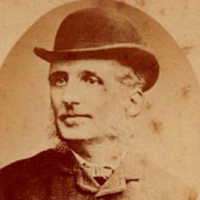Thomas Henry Burke (civil servant)
Thomas Henry Burke (29 May 1829 – 6 May 1882) was Permanent Under Secretary at the Irish Office for many years before being killed during the Phoenix Park Murders on Saturday 6 May 1882. The killing was carried out by an Irish republican organisation called the Irish National Invincibles. The newly appointed Chief Secretary for Ireland Lord Frederick Cavendish, although not the intended victim, was assassinated alongside him while they walked through Phoenix Park in Dublin. The victims were stabbed in the neck and chest with surgical blades.
Thomas H. Burke | |
|---|---|
 | |
| Born | 29 May 1829 |
| Died | 6 May 1882 (aged 52) |
| Occupation | Permanent Under Secretary at the Irish Office |
| Known for | Phoenix Park Murders |
Thomas Burke was the Invincibles' intended target because he had been working for the British establishment as head of the Civil Service for many years and was associated with the British coercion policy during the Land War, 1879–82.[1] Irish nationalists referred to Burke as the "Castle rat".
Life
Thomas Henry Burke was one of six sons of William Burke of Knocknagur, Tuam, County Galway and Emma Dillon. He was born in Waterslade House,[2] Tuam. He was educated at Oscott College, Sutton Coldfield, near Birmingham, and also in Belgium and Germany.[3]
Burke's family was descended from that of Sir Ulick Burke of Glinsk, County Galway, on whom Charles I conferred a baronetcy in 1628. One brother was Sir Theobald Hubert Burke, 13th Baronet of Glinsk, another brother was the artist Augustus Nicholas Burke.[4]
Burke’s outlook
Burke was in favour of both Home Rule[5][6] and reform of land issues, although as a civil servant he did not make his views known publicly. Lord Spencer described him as a “warm-hearted Irishman of strong national tendencies”.[7] Burke's support of various Crimes Acts imposed in Ireland was an issue which marked him out for assassination. Burke supported the retention of the unpopular Act in 1882, though his position was somewhat soft.
...those who have had opportunity to be well informed have always held that Mr. Burke confined himself within the immediate duties of his post, and that he was rather averse then otherwise to coercion...in the opinion of a great many people he has for a long time been the real ruler of the country”.[8]
Burke's attitude towards land issues was demonstrated by his intervention on the Kirwan estate in Carraroe, Co. Galway in 1880. Numerous eviction notices were about to be served on tenants and the chances of confrontation were high. Burke used his personal acquaintance with the Kirwans to attempt to defuse the situation. Burke's report to Forster lamented the
sad flood of light this throws on the Irish land question ... an absentee landlord, careless sub-agents, fraudulent bailiffs and a wretched tenantry.[9]
Funeral and interment
Burke was interred in a private ceremony at Prospect cemetery, Glasnevin on Tuesday, 9 May. The grave is situated at Plot Zb 74 & 75. His remains were removed from the Chief Secretary's Lodge at 9 am, by hearse, followed by 43 carriages containing mourners. The coffin bearing the inscription, "Thomas Henry Burke, Born 29th May 1829, Died 6th May 1882, R.I.P." The Very Rev. Monsignor Lee, Dean of Dublin officiated, assisted by the Rev. E.J. Quinn and Rev. W.J. Hurley. Thomas Burke was laid to rest beside his father William, under a Celtic cross. The ornamental carved stone cover of the grave bears the inscription, "Sacred to the memory of Thomas Henry Burke Esq. Who was murdered in the Phoenix Park on May 6th, 1882. He pleased God and was beloved".
The second monument, composed mainly of black marble from Cong[10] erected adjacent to the grave, bears the inscription,
To the memory of Thomas Henry Burke, Under Secretary to the Lord Lieutenant of Ireland. Assassinated in the Phoenix Park. This monument is erected by his many friends among the Irish Resident Magistrates as a mark of their appreciation of his high character and eminent public service. RIP.
Thomas’ estate at death was £1901 11s. 4d. according to probate records of 7 June 1882.[11]
- Thomas Burke's grave, Prospect cemetery, Glasnevin.
 Monument dedicated to Burke from the Resident Magistrates.
Monument dedicated to Burke from the Resident Magistrates.
Memorial Prize
The Department of Education in Northern Ireland administers the Burke Memorial Fund which was established in 1883,[12] a trust fund from which the payment of an annual prize of £150 is awarded to the best entrant to GCSE examinations taken in Northern Ireland.
Notes
- Land war
- Tuam
- Burke, Thomas Henry by James Quinn, Dictionary of Irish Biography
- Gilbert 1886.
- Florence Arnold-Forster's Irish Journal, Moody T.W. and Hawkins, R.A.J. Clarendon Press, Oxford, 1988. ISBN 0-19-822405-2.
- Loughlin, J., Gladstone, Home Rule and the Ulster Question, 1882–93. Gill & Macmillan, London, 1986. ISBN 0-7171-1471-6.
- Cooke, A.B. and J.R. Vincent, Lord Spenser on the Phoenix Park Murders. Irish Historical Studies, 1973. 18(72): p. 583-591.
- Corfe, T., The Phoenix Park Murders, Conflict Compromise & Tragedy In Ireland 1879–1882. Hodder and Stoughton, London, 1968. ISBN 0-340-02624-3.
- Hawkins, R., Liberals, land and coercion in the summer of 1880: the influence of the Carraroe ejectments. Journal of the Galway Archaeological and Historical Society, 1975. 34: p. 40-57.
- Proposed Monumental Cross, in The Times. London. 18 August 1882
- Gray 2004.
References
- Gilbert, John Thomas (1886). . In Stephen, Leslie (ed.). Dictionary of National Biography. 7. London: Smith, Elder & Co.
- Gray, Peter (2004). "Burke, Thomas Henry (1829–1882)". Oxford Dictionary of National Biography. Oxford University Press.
External links
| Wikimedia Commons has media related to Thomas Henry Burke (civil servant). |
| Government offices | ||
|---|---|---|
| Preceded by Sir Edward Robert Wetherall |
Under-Secretary for Ireland 1869–1882 |
Succeeded by Robert George Crookshank Hamilton |